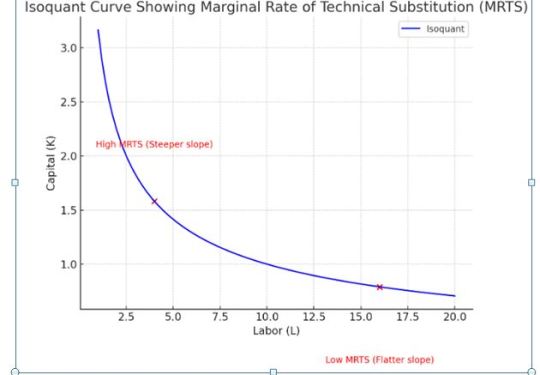Don't wanna be here? Send us removal request.
Text
How MRTS Shapes Technological Efficiency: Help with Economics Concepts
The Marginal Rate of Technical Substitution (MRTS) is increasingly regarded as one of the most significant concepts in economics for the efficient allocation and utilization of resources by businesses and economies. MRTS fundamentally refers to the rate at which input in the production process is substituted for another input, say, labor for capital while keeping the output level constant or at a steady state. Think of it basically as a scale balancer-how much machinery can you replace with more workers or vice versa while producing the same output?
MRTS is important for economics students to understand how firms make decisions about the use of resources. Thus, the use of MRTS makes it easier for companies to determine the right combination of inputs that will enable them to produce more with less cost involved. What you will realize as you go through this concept is how fundamental it is in helping you understand the microeconomic production theory and, at the same time, the emerging trends in technology and enhancing efficiency.

Role of MRTS in Economics
Why is MRTS important in economics? As we know, input costs are one of the major components of the total costs in the production process, and those figures help us analyze them. High MRTS means that input is easily substitutable with another, for example, robots replacing human labor, while low MRTS means the input can hardly be substituted or will cost a lot.
Knowledge of MRTS enables students to discover the effect of upgraded technology or input prices on production decisions by a firm. However, MRTS is not only theoretical; it has practical applications in manufacturing, agriculture, and many other small, large, and even technology-based industries. However, students may face issues while getting familiar with the topics. Seeking professional economics homework help can expose them to new ideas and ways to look at this topic which will help them solve complicated questions and case studies.
Learning about how MRTS Shapes technological advancements and productivity
And how does MRTS shapes the technological advancement and efficiency outcome? To answer that, let us discuss in detail about the link between MRTS and Production Technology. The technology affects the MRTS in that it determines the ability to make inputs to be readily substitutable for one another. Technological progress that enhances the efficiency of capital, for instance, may enhance MRTS, such that firms depend on machines rather than labor.
1. Technological substation and productivity:
Substitution remains one of the most important forms of how MRTS influences technological advancement. Let us take the case of a factory manufacturing cars. If the real wages of labor go up but the price of capital – like robotic machinery as the result of technological progress – goes down, managers will continue to hire robots instead of people to produce the same amount. This is where MRTS plays a key role: Consequently, it explains to the firms the extent to which the total amount of labor can be substituted by machinery without affecting the volume of production.
One of the examples comes from the automotive industry. For instance, in the 1990s Ford and Toyota faced the heat of increasing cost of labor. To help them sustain their competitiveness they made investment in robotic automation to replace labor. The MRTS in these factories changed substantially as capital became more valuable because of the augmented applications of robotics and artificial intelligence. By 2019, it was estimated that more than 10% of car production tasks were done by robots — this is the result of the technological changes that understanding MRTS and efficient ratio of input use brings.
2. Impact on Efficiency
MRTS influences efficiency as well. Technical efficiency (TE) refers to the ability of firms to produce more output for a given quantity of inputs by adopting and implementing new technologies. Companies that possess TE are efficient in their utilization of resources and hence they have lower total production costs. When businesses understand their MRTS they are in a position to reallocate resources between labor and capital making the business more efficient.
For instance, while practicing agriculture technology-based approaches such as precision farming has enabled farmers to use technology in practices replacing the labor-intensive techniques. Today with the assistance of GPS systems, drones, and big data analytics farmers can control their produce and inputs thereby decreasing manpower. The opportunity cost between manual labor and capital equipments in farming has therefore been greatly inclined towards mechanization. Empirical evidence reveals that with precision farming the yields have improved by as much as 25% and reduced expenses by about 15%, facts that depict the actual application of MRTS.
3. Diminishing MRTS and effects of Technology
However, MRTS is not Homogeneous; instead, it decreases when one input is substituted for the other in greater amounts. According to the law of diminishing returns on the production factor, states that while technology can efficiently substitute labor, there comes a time when each additional substitution is less beneficial. For instance, in a production facility already characterized by heavy use of robots such as a highly automated factory, increased use of robots cannot go on increasing the amount of substitution of labor in the same proportion. In the longer term, the firm will require external intervention such as human inputs for those activities that are hard to automate such as problem-solving or decision making.
In the health sector for instance, although technology has pervaded almost every aspect (from diagnostic to robotic surgery) labor is still essential. However, the MRTS between technology and skilled medical labor is reduced because machines are unable to capture the unique decisions that human doctors and nurses are required to make. Therefore, being aware of this limit enhances the capacity to work out better means through which firms /industries would employ technology without compromising human labor.
4. Case Study: Retail – The Technology Shift
Let’s take a closer look at a sector we’re all familiar with: retail. In the last decade, increased use of internet buying and selling and the use of automation has changed the MRTS between human labor and technology in a very big way. Some of the giant organizations, such as Amazon and Walmart, have adopted automated warehouses in which robots are used in sorting, packing as well as shipping of products. Mobile robots have also been adopted by this e-commerce company, with more than 200,000 of them being used in the amazon’s facilities in 2020, thus reducing the human work input in these areas that can be automated easily.
However, over time, the MRTS in retail has evolved towards capital as the technology enhances the efficiency of the operation of logistics. Yet, just like in healthcare, the law of diminishing return of substituting labor with technology here also applies. Personal selling, customer relations, and decisions and choices still involve human intervention. Retailers must analyze the extent to which technology can replace human labor whilst at the same prioritizing the fact that human labor remains relevant for functions that technology has not been able to perform.
Graphical Representation of MRTS
A tool that can be quite helpful in helping us understand the concept of MRTS is the isoquant curve which is a curve where all combinations of two inputs, in this case, labor and capital yield the same level of output. The slope of the isoquant curve at any point reflects the MRTS. When more and more labors are being replaced with capital, the curve flattens and signifies that MRTS is diminishing. Here’s a simple graph of an isoquant curve that can help you understand how firms decide the optimal combination of labor and capital:

In fact, because of technological advancement and changes in the price of inputs, firms are always shifting along the isoquant curve in search of the most effective input.
How Expert Help Can Benefit Students in Solving Economics Assignments on MRTS
Taking a shot at economics can at times be a challenging task especially if you’re faced with concepts such as Marginal Rate of Technical Substitution (MRTS). To the students who usually study economics courses, understanding MRTS means not just memorizing the definitions, but also applying theory in real case problems, analyzing graphs, and solving numerical problems. This is where help with economics homework from professionals can turn out to be quite useful. However, whenever you have a question to solve, an assignment to complete, a case to analyze, or when doing the right graphical analysis of the topic becomes a problem, then turning to experts could help in breaking the complex problems into manageable steps for easy learning.
1. Case Analysis and Graphic Presentation
In many assignments of micro and macroeconomics as well as in production theory and MRTS, graphical analysis seems to be an important tool. One of the most challenging tasks students face is how to effectively interpret and generate graphs that capture interrelationships between labor, capital, and output. Our experts assist learners in understanding isoquant curve construction, calculation of MRTS, and conclusions derived from shifts in these curves due to the changes in either technology or input costs.
Furthermore, while solving cases students also have to use the MRTS concepts to actual business scenario. Our qualified tutors use real-life examples from different industries, to explain to the students how such firms decide to substitute labor with capital and vice versa.
2. Solving numerical and technical problems
Working out specific numerical exercises on MRTS can be quite cumbersome, especially in contexts characterized by numerous and complex calculations of marginal products or input proportions or where optimization problems have to be solved. It will often help students to get a tutor who fully understands the economic models, and who can guide users through the process of breaking down these problems. Not only do they solve the calculations but also explain the economic rationale for each calculation to make sure that students have an understanding of the overall process.
3. Providing Modern Perspectives and Insights
As industries experience a shift propelled by automation and artificial intelligence, studying MRTS from a current standpoint is vital. Using examples that mirror today’s trends and scenarios, such as the substitution of labor by automation in sectors such as e-commerce or healthcare, tutors make students understand how MRTS works. Not only does this make greater sense to the students themselves, but it also provides a more applicable and modern outlook to the course – something which is incredibly beneficial in examinations and prospective career choices.
Conclusion
This post has shown that MRTS is not just an abstract idea and is the key to understanding how firms and industries cope with technological progress and enhance efficiency. MRTS allows the students to study how economies evolve over time, and how firms make production decisions. Whether you are doing your homework or attempting to fully grasp the economic models, do not forget that turning to professional assistance and following credible resources provides new insights and perspectives into MRTS and its practical use.
In general, a student trying to navigate through the different aspects of MRTS, opting for help with economics assignments is a smart choice. No matter what kind of assistance is needed, whether graphical analysis, case studies, or numerical problems, our professional tutors are of huge benefit in presenting a students with a fresh approach, and imparting competitive advantage of solving their tasks with confidence. Therefore, the next time you are in a dilemma in solving an economics problem or case study, you should not hesitate to seek our help. Mastering economics becomes a whole lot easier with the help of a competent tutor.
0 notes